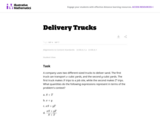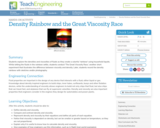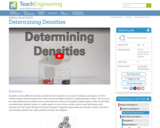
Students must convert yards to feet to solve this word problem.
- Subject:
- Math
- Material Type:
- Activity/Lab
- Provider:
- Illustrative Mathematics
- Provider Set:
- Illustrative Mathematics
- Author:
- Illustrative Mathematics
- Date Added:
- 05/01/2012

Students must convert yards to feet to solve this word problem.

By tracing the movement of radiation released during an accident at the Chernobyl nuclear power plant, students see how air pollution, like particulate matter, can become a global issue.

The purpose of this task is to help students explore the meaning of fraction division and to connect it to what they know about whole-number division.

This task asks the students to solve a real-world problem involving unit rates (data per unit time) using units that many teens and pre-teens have heard of but may not know the definition for. While the computations involved are not particularly complex, the units will be abstract for many students.

Students explore the many different ways that engineers provide natural lighting to interior spaces. They analyze various methods of daylighting by constructing model houses from foam core board and simulating the sun with a desk lamp. Teams design a daylighting system for their model houses based on their observations and calculations of the optimal use of available sunlight to their structure.

This feature article from the National Aeronautics and Space Administration's Earth Observatory discusses the use of satellite imagery to evaluate desertification which is occurring in the Sahel, a region of central African savannah that forms the boundary between the Sahara Desert to the north and the wetter, more fertile regions to the south. Topics include the use of Very High Resolution Radiometer (VHRR) data, obtained from National Oceanic and Atmospheric Administration (NOAA) meteorological satellites, to develop a vegetation index, and exactly how the term 'desertification' should be defined in order to distinguish temporarily degraded land from that which has permanently lost productivity.

The primary purpose of this task is to illustrate certain aspects of the mathematics described in the A.SSE.1. The task has students look for structure in algebraic expressions related to a context, and asks them to relate that structure to the context. In particular, it is worth emphasizing that the task requires no algebraic manipulation from the students.

Students explore the densities and viscosities of fluids as they create a colorful 'rainbow' using household liquids. While letting the fluids in the rainbow settle, students conduct 'The Great Viscosity Race,' another short experiment that illustrates the difference between viscosity and density. Later, students record the density rainbow with sketches and/or photography.

Students design and build small catapults to launch candy pieces.

The purpose of this activity is for the students to draw a design for their own flying machine. They will apply their knowledge of aircraft design and the forces acting on them. The students will start with a brainstorming activity where they come up with creative uses for every day objects. They will then use their creativity and knowledge of airplanes to design their own flying machine.

Students create a concept design of their very own net-zero energy classroom by pasting renewable energy and energy-efficiency items into and around a pretend classroom on a sheet of paper. They learn how these items (such as solar panels, efficient lights, computers, energy meters, etc.) interact to create a learning environment that produces as much energy as it uses.

In this two-part activity, students design and build Rube Goldberg machines. This open-ended challenge employs the engineering design process and may have a pre-determined purpose, such as rolling a marble into a cup from a distance, or let students decide the purposes.

Student teams act as engineers and brainstorm, design, create and test their ideas for packaging to protect a raw egg shipped in a 9 x 12-in envelope. They follow the steps of the engineering design process and aim for a successful solution with no breakage, low weight, minimal materials and recyled/reused materials. Students come to understand the multi-faceted engineering considerations associated with the packaging of items to preserve, market and safely transport goods.

Students find and calculate the angle that light is transmitted through a holographic diffraction grating using trigonometry. After finding this angle, student teams design and build their own spectrographs, researching and designing a ground- or space-based mission using their creation. At project end, teams present their findings to the class, as if they were making an engineering conference presentation. Student must have completed the associated Building a Fancy Spectrograph activity before attempting this activity.

Students investigate circuits and their components by building a basic thermostat. They learn why key parts are necessary for the circuit to function, and alter the circuit to optimize the thermostat temperature range. They also gain an awareness of how electrical engineers design circuits for the countless electronic products in our world.

Flexible Learning is a type of curriculum design applied in formal education and training so as to offer people more choice, personalization and control of their learning to suit particular needs. This course has been developed by staff in the Educational Development Centre of Otago Polytechnic and is designed to help both formal and informal learners access and interpret models, research and professional dialogue in flexible learning.

Students are introduced to detail drawings and the importance of clearly documenting and communicating their designs. They are introduced to the American National Standards Institute (ANSI) Y14.5 standard, which controls how engineers communicate and archive design information. They are introduced to standard paper sizes and drawing view conventions, which are major components of the Y14.5 standard.

Students use two different methods to determine the densities of a variety of materials and objects. The first method involves direct measurement of the volumes of objects that have simple geometric shapes. The second is the water displacement method, used to determine the volumes of irregularly shaped objects. After the densities are determined, students create x-y scatter graphs of mass versus volume, which reveal that objects with densities less than water (floaters) lie above the graph's diagonal (representing the density of water), and those with densities greater than water (sinkers) lie below the diagonal.

Readings and resources to help adult learners.

This task supports students in correctly writing numbers. Because students have to trace the number, instead of coloring in a bubble with the number in it or circling the correct number, they gain handwriting practice as well as counting and addition practice.